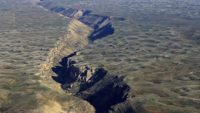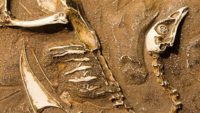By Ken Ham The ice age, a time of wooly mammoths, saber-toothed cats, and glaciers, may seem like a great mystery. But it’s not a mystery when we start with the history found in God’s Word. Indeed, that history actually explains how an ice age is even possible—in a secular worldview it’s very difficult to explain one ice age, let alone the many that secularists believe in. Now, you may be wondering what the Bible says about the ice age. Well, the Bible doesn’t specifically tell us there was an ice age, but we can observe today that there was [More]
Salamander-like footprints preserved in sandstone have long fascinated Grand Canyon hikers and rafters. Insights from a new study of the track patterns intensify an old trackway mystery. But Noah’s Flood can help solve this mystery. It boils down to this: How could a four-footed track maker leave so many details of its foot if it was walking on windblown sand dunes? Footprints in dry sand leave shapeless divots … More… …read more Source: icr.org
Every student in US public schools will likely come across illustrations claiming the earth’s tectonic plates have been moving slowly for millions of years. …read more Source: AIG Daily
After speaking at a church recently, a young man approached me. I thought he might have a question. Instead, he handed me a 6-page essay he had written. It was a defence of a form of Day-Age creationism, the belief that the days of Genesis were actually long periods of time. Normally, I would not spend too much time on such a thing, but the young man impressed me as humble and studious. He also reminded me of myself at that age, when I was trying to defend that very same position. But when I read his paper, I saw [More]
The remarkable fossils found in the Cambrian rocks provide devastating evidence against Darwin’s theory. …read more Source: creation.com
What evidence do we see that a global Flood devastated the earth’s surface during Noah’s day—on a scale unlike anything we see today? …read more Source: AIG Daily
In 1994, Bolivian workers quarrying high-grade limestone for cement reached a layer with too much quartz, a hard mineral, so they left it alone.1 As quarrying continued, more and more of the unwanted layer was exposed, forming a huge cliff and revealing hundreds of dinosaur trackways. The tracks are of at least eight different kinds of dinosaurs, including a pair of titanosaurs and a herd of 16 ankylosaurs. The layer also contains the longest dinosaur trackway in the world, over 500 m (1,640 ft), by a small theropod,1 possibly a juvenile Tyrannosaurus rex.2 Read More: The Cal Orcko (‘Lime [More]
By Kurt P. Wise Fossil Grove offers multiple evidences in support of a huge forest biome floating atop the world’s pre-Flood oceans. …read more Source: AIG Daily
By Dr. Andrew A. Snelling Most people, including Christians, would still claim dogmatically that the earth looks old. But why does the earth supposedly look old? …read more Source: AIG Daily
Since the 1990s, cross-section images of mantle tomography have shown visible slabs of oceanic lithosphere (which includes oceanic crust) descending hundreds of miles beneath ocean trenches into subduction zones.1 These descending plates have been imaged all the way down to the top of the earth’s outer core2 and are composed of cold, brittle, dense rock about 62 miles thick. Researchers from the Univ… More… …read more Source: icr.org
Do ‘laterite’ soils take a million years to form? …read more Source: creation.com
Scientific experiments confirm that dead crocodiles need to be buried quickly in sediment to fossilize. Read More
According to modern sedimentation rates, are there enough sedimentary rocks to span the millions of years of ‘geologic time’? Read More
By Harry F. Sanders, III Ichthyosaurus is well studied, and research on their skeletons has provided evidence for incredible design and the global flood. …read more Source: AIG Daily
By Tim Chaffey Are dinosaurs proof of millions of years of evolution? Or a reminder of God’s glory? …read more Source: AIG Daily
Do these skulls prove common ancestry between apes and humans? Read More
By Harry F. Sanders, III Fossils are often found where they are not expected, and these finds cause evolutionists to frequently revise their timelines. …read more Source: AIG Daily
Unusually deep evaporite deposits underneath the Mediterranean have some scientists scratching their heads-but there is a biblical answer to the mystery. …read more Source: creation.com
Secular scientists recently determined that most of the dinosaur fossils in the Morrison Formation were buried quicker than commonly thought.1 The Morrison Formation is famous for its compositional consistency and massive extent across the American West, covering nearly 700,000 square miles, and for its rich dinosaur quarries. The Morrison Formation is remarkable for its dinosaur fossils an… More… …read more Source: icr.org
By Dr. Andrew A. Snelling Forming the coveted qualities of jade requires unique conditions unlike anything on earth today. …read more Source: AIG Daily
Could feathered dinosaurs have existed? Logically distinct question: did dinosaurs evolve into birds? Read More
Massive coastal sand dunes were most likely formed both before the post Flood Ice Age, and immediately after the post Flood Ice Age. Read More
Ever seen sedimentary rock layers in cliffs? They were deposited in rapid water currents, sideways Read More
In 2015, schoolteacher and amateur fossil hunter Philip Mullaly discovered a number of three-inch teeth of what would later be classified as the large Great Jagged Narrow-Toothed shark (Carcharocles angustidens).1 The teeth were found along a beach in Victoria, Australia. A three-inch tooth would have come from a shark in the neighborhood of 25 feet long—longer than the biggest recorded Great White. … More… …read more Source: icr.org
The recent Alaskan discovery of an unusual assemblage of footprints in Cretaceous rocks has paleontologists scratching their heads. Anthony Fiorillo, of the Perot Museum of Nature and Science and his co-authors, reported the trackway discovery in Scientific Reports.1 The numerous footprints were found in Denali National Park in central Alaska in the Cretaceous Lower Cantwell Formation. &nbs… More… …read more Source: icr.org
How do creationists explain them? …read more Source: creation.com
By Ken Ham The evidence for the global flood is all around us—the rocks cry out their testimony to the truth of God’s Word. Sadly at most of the sites of these great testimonies to the flood and its aftermath, the signage refuses to acknowledge how this catastrophe and its aftermath shaped geology. Instead they appeal to slow, gradual processes over millions of years to explain various geological features. But when you reject the greatest catastrophe off all time, you won’t come to the right interpretation of the evidence! We encourage people to view natural wonders such as the Grand [More]




































